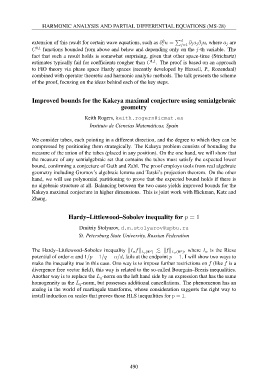Page 492 - 8th European Congress of Mathematics ∙ 20-26 June 2021 ∙ Portorož, Slovenia ∙ Book of Abstracts
P. 492
MONIC ANALYSIS AND PARTIAL DIFFERENTIAL EQUATIONS (MS-28)
extension of this result for certain wave equations, such as ∂t2u = d ∂j aj ∂j u, where aj are
j=1
C0,1 functions bounded from above and below and depending only on the j-th variable. The
fact that such a result holds is somewhat surprising, given that other space-time (Strichartz)
estimates typically fail for coefficients rougher than C1,1. The proof is based on an approach
to FIO theory via phase space Hardy spaces (recently developed by Hassell, P., Rozendaal)
combined with operator theoretic and harmonic analytic methods. The talk presents the scheme
of the proof, focusing on the ideas behind each of the key steps.
Improved bounds for the Kakeya maximal conjecture using semialgebraic
geometry
Keith Rogers, keith.rogers@icmat.es
Instituto de Ciencias Matemáticas, Spain
We consider tubes, each pointing in a different direction, and the degree to which they can be
compressed by positioning them strategically. The Kakeya problem consists of bounding the
measure of the union of the tubes (placed in any position). On the one hand, we will show that
the measure of any semialgebraic set that contains the tubes must satisfy the expected lower
bound, confirming a conjecture of Guth and Zahl. The proof employs tools from real algebraic
geometry including Gromov’s algebraic lemma and Tarski’s projection theorem. On the other
hand, we will use polynomial partitioning to prove that the expected bound holds if there is
no algebraic structure at all. Balancing between the two cases yields improved bounds for the
Kakeya maximal conjecture in higher dimensions. This is joint work with Hickman, Katz and
Zhang.
Hardy–Littlewood–Sobolev inequality for p = 1
Dmitriy Stolyarov, d.m.stolyarov@spbu.ru
St. Petersburg State University, Russian Federation
The Hardy–Littlewood–Sobolev inequality Iαf Lq(Rd) f ,Lp(Rd) where Iα is the Riesz
potential of order α and 1/p − 1/q = α/d, fails at the endpoint p = 1. I will show two ways to
make the inequality true in this case. One way is to impose further restrictions on f (like f is a
divergence free vector field), this way is related to the so-called Bourgain–Brezis inequalities.
Another way is to replace the Lq-norm on the left hand side by an expression that has the same
homogeneity as the Lq-norm, but possesses additional cancellations. The phenomenon has an
analog in the world of martingale transforms, whose consideration suggests the right way to
install induction on scales that proves those HLS inequalities for p = 1.
490
extension of this result for certain wave equations, such as ∂t2u = d ∂j aj ∂j u, where aj are
j=1
C0,1 functions bounded from above and below and depending only on the j-th variable. The
fact that such a result holds is somewhat surprising, given that other space-time (Strichartz)
estimates typically fail for coefficients rougher than C1,1. The proof is based on an approach
to FIO theory via phase space Hardy spaces (recently developed by Hassell, P., Rozendaal)
combined with operator theoretic and harmonic analytic methods. The talk presents the scheme
of the proof, focusing on the ideas behind each of the key steps.
Improved bounds for the Kakeya maximal conjecture using semialgebraic
geometry
Keith Rogers, keith.rogers@icmat.es
Instituto de Ciencias Matemáticas, Spain
We consider tubes, each pointing in a different direction, and the degree to which they can be
compressed by positioning them strategically. The Kakeya problem consists of bounding the
measure of the union of the tubes (placed in any position). On the one hand, we will show that
the measure of any semialgebraic set that contains the tubes must satisfy the expected lower
bound, confirming a conjecture of Guth and Zahl. The proof employs tools from real algebraic
geometry including Gromov’s algebraic lemma and Tarski’s projection theorem. On the other
hand, we will use polynomial partitioning to prove that the expected bound holds if there is
no algebraic structure at all. Balancing between the two cases yields improved bounds for the
Kakeya maximal conjecture in higher dimensions. This is joint work with Hickman, Katz and
Zhang.
Hardy–Littlewood–Sobolev inequality for p = 1
Dmitriy Stolyarov, d.m.stolyarov@spbu.ru
St. Petersburg State University, Russian Federation
The Hardy–Littlewood–Sobolev inequality Iαf Lq(Rd) f ,Lp(Rd) where Iα is the Riesz
potential of order α and 1/p − 1/q = α/d, fails at the endpoint p = 1. I will show two ways to
make the inequality true in this case. One way is to impose further restrictions on f (like f is a
divergence free vector field), this way is related to the so-called Bourgain–Brezis inequalities.
Another way is to replace the Lq-norm on the left hand side by an expression that has the same
homogeneity as the Lq-norm, but possesses additional cancellations. The phenomenon has an
analog in the world of martingale transforms, whose consideration suggests the right way to
install induction on scales that proves those HLS inequalities for p = 1.
490


